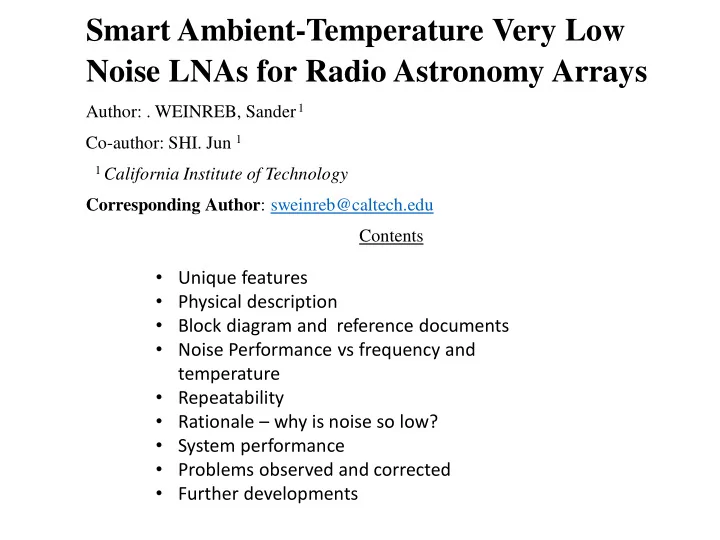

Smart Ambient-Temperature Very Low Noise LNAs for Radio Astronomy Arrays Author: . WEINREB, Sander 1 Co-author: SHI. Jun 1 1 California Institute of Technology Corresponding Author : sweinreb@caltech.edu Contents • Unique features • Physical description • Block diagram and reference documents • Noise Performance vs frequency and temperature • Repeatability • Rationale – why is noise so low? • System performance • Problems observed and corrected • Further developments
Unique Features of LNA ▪ Four times lower noise than commercially available LNA’s in the 1.4 GHz range ▪ System noise comparable to that obtained with cryogenic receivers at a fraction of the cost. ▪ Temperature-compensated Internal noise calibration source to eliminate noise due to external coupler ▪ One wire operation – DC power and calibration noise control all through the output coax ▪ Gain varies <1dB from +40 to -40C 16-Sep-2020 Weinreb/Shi Radionet 2
Physical Description • LNA is in a waterproof enclosure, 86 x 50 x 24 mm • To avoid noise due to input cable the LNA must be mounted directly on the feed or be integrated into the feed. 16-Sep-2020 Weinreb/Shi Radionet 3
Block Diagram of LNA Reference Documents S. Weinreb and J. Shi, “Low Noise Amplifier with 7K Noise at 1.4 GHz and 25C”, Submitted for Publication, IEEE MTT Transactions, Aug 6, 2020. J. Shi and S.Weinreb , “Internal LNA Noise Calibration Source”. To be submitted. Draft Aug 13. 2020 16-Sep-2020 Weinreb/Shi Radionet 4
Measured LNA Noise vs Frequency at +40, 0, and -40C and Modeled Noise at +40C 16-Sep-2020 Weinreb/Shi Radionet 5
Repeatability Measurements vs temperature at 1.4 GHz of 22 LNAs showing average noise temperature, T50, measured with 50 ohm source, and the rms deviation for this average. Also shown it the transistor hot-electron noise. Tdrain, vs temperature determined for the average 16-Sep-2020 Weinreb/Shi Radionet 6
Rationale for Performance - Transistor • Exceptional Diramics InP HEMT Transistor. See https://diramics.com/wp- content/uploads/downloads/DIRAMICS-pH-100-4F62p5.pdf. LNA uses a scaled version, 4F50, of this transistor with the noise model shown below at 25C. Microscope views of the 4F50 transistor are also shown. 16-Sep-2020 Weinreb/Shi Radionet 7
Rationale for Performance - Input Network • Low Loss Input Transmission Line – Microstrip transmission lines are used in most LNAs in this frequency range. The typical loss of a microstrip line 10mm long from the transistor die to input connector is 0.20 dB which contributes 14K to the LNA noise. In addition, the range of characteristic impedances needed to noise match the transistor is not available in microstrip. The LNA design first used an air coax input line but then switched to suspended substrate to facilitate connection to a bond wire to the transistor and a coupling capacitor. Suspended-substate. The Coaxial line similar in loss blue region is a low loss and Zo to the suspended- dielectric PCB material substrate at right 16-Sep-2020 Weinreb/Shi Radionet 8
System Performance • Measured on 4.6m paraboloid at Caltech Owens Valley Radio Observatory, Feb 23, 2020 • Top curve is LNA output spectrum, 1.0 to 1.8 GHz, with absorber at 290K covering the feed • Bottom curve is with antenna pointed at sky showing 10 dB Y factor at 1.4 GHz. 16-Sep-2020 Weinreb/Shi Radionet 9
Measured System Noise vs Zenith Angle for Two Polarizations at 1.4 GHz 16-Sep-2020 Weinreb/Shi Radionet 10
Composition of System Noise Temperature 16-Sep-2020 Weinreb/Shi Radionet 11
Problems Observed and Corrected in First Three Months of Operation of ~ 30 LNAs • Water Damage ➢ Noise of several LNA’s exposed to outdoors increased by several K ➢ When cover was removed oxide coating was observed on input circuit ➢ Tests of water vapor deposit (from steam) on transistor chip showed it was protected by passivation coating ➢ LNA case was revised to provide O-ring seals which solved the problem ▪ Cleaning Problem ➢ Several LNAs had noise in the 12K to 16K range when tested. ➢ After many tests it was determined that the problem was small particles in the 1um to 5um range getting trapped in the transistor air bridges during the alcohol cleaning process ➢ Problem has been solved by cleaning the LNA chassis and PCB before the transistor chip is installed. 16-Sep-2020 Weinreb/Shi Radionet 12
Further Developments • Wider Frequency Range ➢ Extend the frequency range to 0.7 to 2 GHz for a proposed DSA2000 array ➢ Extend frequency to the 5 GHz and 8 GHz range for space to ground satellite communication arrays. ➢ For the above a waveguide LNA mount and sloping-septum circular polarizer have been studied • Peltier Cooling to -40C ➢ Cool just transistor die (~0.5mm square) to -40C using a micro-cooler ➢ Transistor produces 8mW heat and bond wire connection, convection, and radiative cooling total 30mW of heating ➢ Cooler at right has 2mm square top plate and can cool 30mW to -40C with 1W heat generated at bottom plate. 16-Sep-2020 Weinreb/Shi Radionet 13
Recommend
More recommend